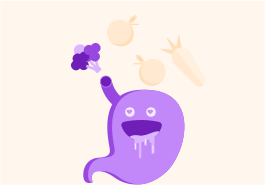YOU ARE LEARNING:
Products of Digestion, Digestive Enzymes and Bile

Products of Digestion, Digestive Enzymes and Bile
The products of digestion come from carbohydrates, lipids and proteins, a process that is supported by enzymes. We will also look at the function of bile.
True or false? Chewing food breaks it down into small enough pieces that it can be absorbed into our blood and be used by our cells.

Chewing food is only the first part of breaking down food. We call that mechanical digestion. It needs to be broken down even more by chemical digestion before it is small enough to be absorbed.
Mechanical breakdown
You start to break down food mechanically, (physically) when you chew it into smaller pieces. After chewing, you swallow small amounts of food.
Chemical breakdown
Chemical breakdown of food involves enzymes. These are special proteins that speed up reactions, in this case they allow long complex chemicals to be broken down into smaller simpler ones.
What are the main nutrients in food that will need to be broken down by the enzymes?

You can select multiple answers
The mouth
The mouth is where mechanical breakdown of food takes place, but it is also where chemical breakdown begins. What is the liquid called that covers the food as you chew?

Saliva has two main functions. What do you think they might be?

You can select multiple answers
The enzyme in the saliva is amylase. Amylase is one of a group of enzymes that we call the carbohydrase enzymes, because they break down large carbohydrates into smaller ones. Which of these equations shows the action of amylase?

The stomach
In the stomach, a group of enzymes called the proteases break down the proteins in the food.
Enzymes require the right pH conditions to work efficiently.
To create the right conditions for these enzymes, the stomach produces what other chemical?

The protease enzymes need pH 2 conditions.
Over a few hours they convert proteins into smaller chemicals.
What smaller molecules are proteins broken down into inside the stomach?

Small intestine
The small intestine extends from the bottom of the stomach to the start of the large intestines.
However, only the first section is involved in digestion. The rest of it, almost 3.5 m in length, is used to absorb the products of digestion.
What is this first section of the small intestines called?

What major food molecules have not been broken down by either the actions of the stomach or the mouth?

In the duodenum ** lipase enzymes break down lipids (oils and fats). What is the digestive product of breaking down lipids? Pick all the options you think are correct.

You can select multiple answers
Unlike protease enzymes, lipase enzymes do not work in acidic conditions. They prefer a pH neutral environments. A chemical called bile is added to change the pH in the duodenum. What pH do you think bile must be to change the pH?

Bile **** is an alkaline mixture of salts and other chemicals. It is produced in the liver and stored in a small sack called the gall bladder until it is needed by the duodenum.
Bile also has another function. Lipids don't mix well with water, the bile helps emulsify the fats so that they can react with the lipase enzymes and be broken down. What do you think emulsify means?

So it is in the duodenum that the final stages of digestion take place. Lipids are broken down into fatty acids and glycerols and any remaining carbohydrates are also digested.
What happens to all these products of digestion? Pick all the options you think are correct.

You can select multiple answers
Digestion summary
Mouth
starch+amylase→maltose (sugar)
Stomach
proteins+protease+(HCl)→amino acids
Duodenum
lipids+lipase+(bile)→fatty acids+glycerol Also, remaining carbohydrates are digested by carbohydrase enzymes.
As well as chemical breakdown, the mouth performs one other important function as part of digestion. Which one? Chew on this question for a while if you are not sure.

